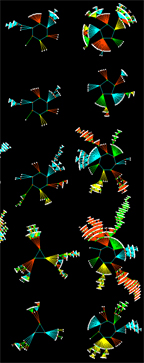
home | links | compass

Tower of Babel. 1928.
by M.C. Escher
LINKS
References
von Ahn on Human
Computation
AI Conferences
Animating Time Data
Climate Collab
Darwin papers
EO Wilson Foundation
Gapminder
Geo-tagger's World Atlas
Gordon Lab
Innovation Networks
IRIDIA
Kelly - Hivemind
Kirschner Lab
London Open Street Map
Los Alamos – Symbiotic
Intelligence
Microbes–Mind Forum
MIT Center for
Collective Intelligence
Planet Innovation
Recommender Systems
SIGCHI
SIGEVO
SIGGRAPH
Turner Fieldwork
Vinge on Singularity
Wall Street Journal
ON C-IQ
Google Tech Talk
Innovation Networks
SAP Labs Future Salon
BOOKS
![]()
Ehrlich - Humanity
on a Tightrope
![]()
Kelly – What
Technology Wants
![]()
Axelrod – Evolution
of Cooperation
![]()
Axelrod – Complexity
of Cooperation
![]()
Hansen, Schneiderman,
Smith – Analyzing Social
Networks - Node XL
![]()
J Fodor & M P
What Darwin Got Wrong
![]()
E Jablonka & M Lamb
Evolution in 4D
![]()
M Kirschner & J Gerhart –
Plausibility of Life
![]()
J Scott Turner
Tinkerer's Accomplice
![]()
J Scott Turner
The Extended Organism
![]()
MJ West-Eberhard –
Developmental
Plasticity & Evolution


Image Credit above
Andrew Wuensche, DDL
Random Boolean Networks
Collaborative intelligence |
|
Why does collaborative intelligence matter? How will developing collaborative intelligence method and tools make money? It's our best hope of saving our world, which is not merely worth trillions of dollars. It's worth everything — civilization and the future of life on Earth. |
||
From juries to boards of directors to collaborative networks, decisions are made, either individually or collectively. What can we learn from evolution and living systems to inform decision-making and innovation? How can we better harness our capacity for pattern recognition — our diverse expertise and perspectives to improve our ability to recognize and interpret patterns? |
|||
 |
|||
Whether groups can be supported to make better decisions matters. Extending the work of Irving Janis, James Surowiecki argues that the study of groups is important for two reasons: “First, small groups are ubiquitous in American life, and their decisions are consequential. And second, small groups are different in important ways from groups such as market or betting pools or television audiences." Surowiecki alludes to a different collective from what he examined in The Wisdom of Crowds. This site emphasizes the critical difference lies not in size but in the fact that collaborative intelligence engages contributors who are not anonymous. Contemporary thinkers cite the urgent need for a long term environmental sustainability strategy. Central to arguing this case is the work of Professor Paul Ehrlich of the Center for Conservation Biology and the work of a large and growing number of thinkers making a case for urgency. From a technology perspective, Kevin Kelly makes the case in What Technology Wants that the Technium, much like life itself, has its own driving force, propelling its own evolution. “Collaboration” suffers from its history as a value-laden term, lacking substantive theory, method, or tools. Robert Axelrod’s pioneering study, The Evolution of Cooperation, given today's specification of "cooperation" to refer to tasks where all contributors perform the same role (as in rowing a boat) and "collaboration" to refer to tasks where contributors may perform different roles, should have been titled The Evolution of Collaboration because all of his players bring their unique strategies to the game. Axelrod showed that an argument for efficacy can be constructed without resorting to ethics. Today, broad recognition of the growing impact of global warming, and a range of initiatives toward sustainability, call for better cross-disciplinary knowledge-sharing systems and problem-solving tools. Environmental sustainability demands a method and tools not only to fuse data but to filter and integrate our differing interpretations of data — to recognise patterns and support innovation networks driven by individuals with unique leadership skills, ideas, and priorities. These project leaders need problem-mapping and project visualisation “empty construct” plug-ins to share knowledge and track problem-solving in process, enhancing communication across disciplines. We need a method to apply our collaborative intelligence to sustainability challenges. Just as we cannot reach a consensus of all scientists that global warming is a fact, or that overpopulation is a threat, or that humanity is fundamentally an ethical species (or not), those premises about collaborative intelligence that remain speculative also deserve serious consideration, whether or not they can be tested or proven. First, we wrongly tend to assume that individuality is the foundation for competition, that collaboration requires the suppression of individuality to an agreed consensus. A paradigm shift is needed to understand that exactly the opposite is true. The argument to support this paradigm shift is well-accepted in evolutionary biology. Evolutionary theorists assert that individual differences make evolutionary adaptation possible. Without differences among replicating organisms, evolution could not generate more fit adaptations. This critical principle from evolutionary theory is the foundation for collaborative intelligence. The central role that individuality plays in driving evolutionary innovation parallels the role that individuals play in creating collaborative ecosystems for effective problem-solving. Second, the A-PR Hypothesis (Autonomy and Pattern Recognition) is proposed as a single unifying principle that defines both life and intelligence, underpinning collaborative intelligence. Our conventional problem-solving model emphasises “objective analysis of the facts,” which cannot tackle many of the problems we face today. Such problems require systematic data-gathering, as well as collection of diverse interpretations of data, harnessing each expert’s autonomy and unique pattern recognition capacities (A-PR ) to drive the synthesis of diverse views toward an optimal outcome. Collaborative intelligence proposes a systematic method to harness individual capacities for pattern recognition and interpretation in problem-solving. Third, life’s own designing intelligence, the foundation for collaborative intelligence, is embedded in the Dyadic Model, which characterizes competition and collaboration as complementary, co-equal dynamics in evolution. The traditional view that competition for “survival of the fittest” drives evolutionary adaptation is increasingly being complemented by the more recent view that collaboration is not subordinate, but rather co-equal in promoting evolution’s advance toward improved adaptation. I argue, with supporting evidence from the life sciences, that synthesis can be approached as systematically as analysis, recognising that, as in Nature, the process of synthesis must be flexible to adapt and evolve as new information arrives. Fourth, Garrett Hardin posited the Tragedy of the Commons (1968): Each agent, pursuing his own self-interest for survival of the fittest, exploits shared resources to everyone’s detriment. Collaborative intelligence addresses the challenge posed by Garrett Hardin’s timely warning: What theory, method, and tools can we use to harness our collaborative intelligence to manage the commons? The thesis proposes an approach that relies on the principle of collaborative autonomy, proposed as a prerequisite for collaborative intelligence, and shows how the dynamics of convergence (rather than consensus) can overcome “the consensus barrier,” succeeding where other methods have failed. Fifth, the Tripod Learning Model is proposed as a vehicle to derive and teach collaborative intelligence and illustrated using the intersection of the work of Irving Janis, James Lovelock, and Buckminster Fuller.
Analysis can dissect and interpret the past in order to make projections into the future. Although our data and interpretation of the past may change, the past itself is static. Synthesis constructs the future, adopting a constructivist, proactive stance, making interventions, assessing their impact, attempting to bring order to a set of elements that are themselves shifting through time, even as the process of synthesis progresses. Not only do circumstances and priorities shift, the components subject to synthesis are themselves changing, making synthesis a harder problem to manage than analysis, a problem that requires a more systematic method. Data fusion has contributed to our capacity to interpret and use data. We need equally systematic methods for cross-disciplinary knowledge fusion for innovation and problem-solving — to “raise the collaborative intelligence” of cross-disciplinary teams. The premise that synthesis can be as systematic as analysis and can be as rigorously studied as analysis, that design method complements scientific method, calls for recognition of the broad significance of design thinking for innovation. More attention given to synthesis, and to collaborative, as opposed to competitive, models for problem-solving, could drive a shift toward new learning models and innovative curriculum. The discipline of Collaborative Intelligence should sit alongside Collective Intelligence and Negotiation Studies as a means to address complex, cross-disciplinary problems with conflicting priorities, such as eco-sustainability. Jeff Gore: "Cooperation and cheating in microbes" MIT Department of Physics. David Rand: "Reward, punishment and the evolution of human cooperation" Harvard. Department of Evolutionary Dynamics. Collaborative Intelligence and the Commons Although in the ecological domain Garrett Hardin’s seminal journal article in Science is one of the most cited works ever produced, it has not, been cited to support work on collaborative intelligence because the field is so new. The year after publication of Hardin’s paper, Beryl Crowe published “The Tragedy of the Commons Revisited,” highlighting “that there is a subset of problems, such as population, atomic war, and environmental corruption, for which there are no technical solutions” and “no current political solutions,” that these problems threaten human existence and that, “in passing the technically insoluble problems over to the political and social realm for solution, Hardin made three critical assumptions: (1) that there exists, or can be developed, a ‘criterion of judgment and system of weighting . . . that will ‘render the incommensurables . . . commensurable’ . . . in real life; (2) that, possessing this criterion of judgment, ‘coercion can be mutually agreed upon,’ and that the application of coercion to effect a solution to problems will be effective in modern society; and (3) that the administrative system, supported by the criterion of judgment and access to coercion, can and will protect the commons from further desecration.” This citation emphasises the conflict among theorists working on sustainability. Collaborative intelligence provides a foundation to develop systems for decision support to analyse risks and tradeoffs, and to design computational environments to support collaborative decision-making for these problems. As literature on sustainability technologies grows exponentially, the sub-domain of decision support for cross-disciplinary, sustainable decision-making remains a hard problem. Implementing collaborative intelligence relies on digital technologies, linking our ecological commons with the new digital commons, translating principles from one domain to the other. Hardin, Garrett. 1960. The Competitive Exclusion Principle. Science 131: 1292-1297. |
|||
|
|||
![]()
![]()